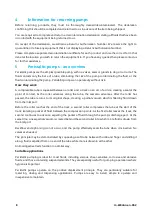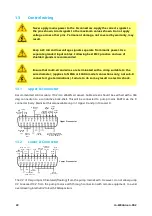
9.2
Dos and don'ts
l
Do not build a pump into a tight location without adequate airflow around the pump.
l
Do keep delivery and suction tubes as short and direct as possible - though ideally not shorter than
one metre - and follow the straightest route. Use bends of large radius: at least four times the tubing
diameter. Ensure that connecting pipework and fittings are suitably rated to handle the predicted
pipeline pressure. Avoid pipe reducers and lengths of smaller bore tubing than the pumphead
section, particularly in pipelines on the suction side. Any valves in the pipeline must not restrict the
flow. Any valves in the flow line must be open when the pump is running.
l
Do ensure that on longer tube runs at least one metre of smooth bore, flexible tubing is connected
to the inlet and discharge port of the pumphead to help to minimise impulse losses and pulsation in
the pipeline. This is especially important with viscous fluids and when connecting to rigid pipework.
l
Do use suction and delivery pipes equal to or larger than the tubing diameter bore. When pumping
viscous fluids use pipe runs with a bore several times larger than the pump tube.
l
Do site the pump at or just below the level of the fluid to be pumped if possible. This will ensure
flooded suction and maximum pumping efficiency.
l
Do run at slow speed when pumping viscous fluids. Flooded suction will enhance pumping
performance, particularly for materials of a viscous nature.
l
Do recalibrate after changing tubing, fluid or any connecting pipework. It is also recommended that
the pump is recalibrated periodically to maintain accuracy.
l
Do not pump any chemical not compatible with the tube or pumphead.
l
Do not run the pump with no tube or element fitted to the pumphead.
l
Do not strap the control and mains cables together.
l
Do ensure if your product has an N module, that the module is fitted with the seals intact and
properly located. Ensure that the holes for the cable glands are properly sealed to maintain the
IP/NEMA rating.
Tube selection: The chemical compatibility guide published on the Watson Marlow website is for
guidance. If in any doubt about the compatibility of a tube material and the duty fluid, request a
Watson-Marlow tube sample card for immersion trials.
When using Marprene or Bioprene continuous tubing, do re-tension the tube after the first 30 minutes
of running.
16
m-630dun-en-08.2
Summary of Contents for 630 Du
Page 81: ...m 630dun en 08 2 81 ...
















































